

WebGL playground [beta] WebGL playground is a straightforward idea: type in your script and see the results. But the cool part is that the editor and the results are just on the same page and that you get a handful of features that make your life easier. No need to create multiple files (html/css/js/glsl), no need to save anything after each update, no need to switch between the editor and the browser, and no need to set up the skeleton code. All necessary things are added behind the scenes. The idea is to shorten the development cycle so you can spend more time on the creative part, trying what-if scenarios, tweaking the parameters ...
Algorithmic worlds - Blog. A blog about algorithmic art and fractal aesthetic.

Click here to subscribe to the RSS feed. February 27th 2011 Recently I've been using a different type of algorithm. It is still related to pattern piling, but I'll explain this in another post. Here I just want speak a bit about the algorithm. A few years ago, a new type of fractal imagery appeared (or at least I hadn't encountered it before), involving fractal patterns apparently filling densely the plane. Dense fractal patterns are exactly what I am after, so I was naturally very interested in these new techniques. Let z be a complex number and define Iabs(z) to be equal to z if the imaginary part of z is positive and its complex conjugate if it is negative. Z = log(Iabs(z)+p) Pixel Bender Technology Center. Pixel Bender development offers many advantages: Low learning curve: Pixel Bender offers a small number of tools that are sufficient to write complex image-processing algorithms.
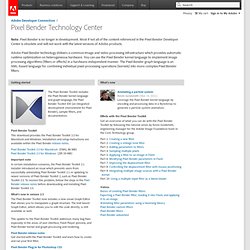
Learning Pixel Bender is easier than learning C/C++ and each application's plug-in SDK. You do not need to know any graphics shading language or multithreading APIs. Parallel processing: Pixel Bender allows the same filter to run efficiently on different GPU and CPU architectures, including multicore and multiprocessor systems. It delivers excellent image processing performance in Adobe products. Introduction to Pixel Bender: Part 1. Projects : Jon McCormack. Developmental Modelling : Jon McCormack. Developmental modelling is concerned with modelling the processes of biological development: morphogenesis.
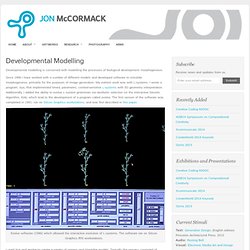
Since 1990 I have worked with a number of different models and developed software to simulate morphogenesis, primarily for the purposes of image generation. My earliest work was with L-systems. I wrote a program, lsys, that implemented timed, parametric, context-sensitive L-systems with 3D geometry interpretation. Additionally, I added the ability to evolve L-system grammars via aesthetic selection (or the Interactive Genetic Algorithm, IGA), which lead to the development of a program called evolve. The first version of the software was completed in 1991, ran on Silicon Graphics workstations, and was first described in this paper. Morphogenetic field. This article is about the concept in developmental biology.
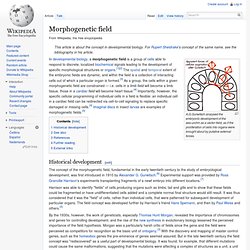
For Rupert Sheldrake's concept of the same name, see the bibliography in his article. A.G.Gurwitsch analysed the embryonic development of the sea-urchin as a vector-field, as if the proliferation of cells into organs were brought about by putative external forces. Historical development[edit] The concept of the morphogenetic field, fundamental in the early twentieth century to the study of embryological development, was first introduced in 1910 by Alexander G.
Gurwitsch.[6] Experimental support was provided by Ross Granville Harrison's experiments transplanting fragments of a newt embryo into different locations.[7] Harrison was able to identify "fields" of cells producing organs such as limbs, tail and gills and to show that these fields could be fragmented or have undifferentiated cells added and a complete normal final structure would still result. Pattern formation. The science of pattern formation deals with the visible, (statistically) orderly outcomes of self-organization and the common principles behind similar patterns in nature.

In developmental biology, pattern formation refers to the generation of complex organizations of cell fates in space and time. Pattern formation is controlled by genes. The role of genes in pattern formation is well seen in the anterior-posterior patterning of embryos from the model organism Drosophila melanogaster (a fruit fly). Examples[edit] Examples of pattern formation can be found in Biology, Chemistry, Physics and Mathematics,[1] and can readily be simulated with Computer graphics, as described in turn below.
Biology[edit] Animal markings, segmentation of animals, phyllotaxis,[2] neuronal activation patterns like tonotopy, and predator-prey equations' trajectories are all examples of how natural patterns are formed. Reaction–diffusion system. Reaction–diffusion systems are mathematical models which explain how the concentration of one or more substances distributed in space changes under the influence of two processes: local chemical reactions in which the substances are transformed into each other, and diffusion which causes the substances to spread out over a surface in space.
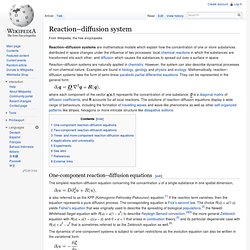
Reaction–diffusion systems are naturally applied in chemistry. However, the system can also describe dynamical processes of non-chemical nature. Examples are found in biology, geology and physics and ecology. Anyone heard of Gray-Scott reaction-diffusion algorithm? Gray-Scott reaction-diffusion java applet. How can patterns be formed by chemical reactions?

A first answer to this question was provided by Alan Turing, who specified mathematical conditions necessary for it to be possible to form spatial patterns in two-component reaction-diffusion systems. The java applet on this page simulates diffusion and reaction between two chemicals U and V. Reaction: U + 2 V -> 3 V The chemical U diffuses faster than V, and is used as fuel to produce chemical V, while chemical V catalyzes its own production. Joakim Linde's home page. Making better CNC halftone pictures. Workgroup Purwins - Reaction Diffusion Systems. Further details with respect to the treatment of reaction diffusion systems Observing nature shows that many temporal and spatial structures are not formed by the outside, but rather by the respective system itself.
Eva Schindling, Reaction-Diffusion algorithm. Reaction-Diffusion Systems. Fragmentarium. Five-point stencil. An illustration of the five-point stencil in one and two dimensions (top, and bottom, respectively).

In numerical analysis, given a square grid in one or two dimensions, the five-point stencil of a point in the grid is made up of the point itself together with its four "neighbors". It is used to write finite difference approximations to derivatives at grid points. One dimension[edit] Reaction-Diffusion by the Gray-Scott Model: Pearson's Parameterization at MROB. Introduction Instructions: A click anywhere in the crescent-shaped complex region will take you to a page with images, a movie and a specific description.
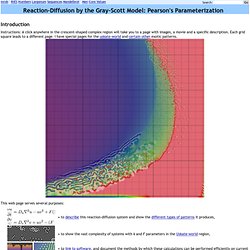
Each grid square leads to a different page. I have special pages for the uskate-world and certain other exotic patterns. This web page serves several purposes: This work led to new discoveries and scientific investigation described below. What Is It? All of the images and animations were created by a computer calculation using the formula (two equations) shown below. Reaction-diffusion - A cross-platform implementation of various reaction-diffusion systems. Www.dna.caltech.edu/courses/cs191/paperscs191/turing.pdf.